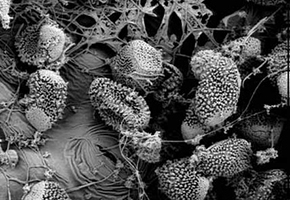

As in the case of its flora and fauna, Brazil likely also has a megadiversity of fungi, bacteria and other microorganisms, say researchers such as Brazilian Alexandre Rosado (photo: Cláudio Arouca/cover: Itamar Soares de Mello, CNPMA/Embrapa)
As in the case of its flora and fauna, Brazil likely also has a megadiversity of fungi, bacteria and other microorganisms, say researchers.
As in the case of its flora and fauna, Brazil likely also has a megadiversity of fungi, bacteria and other microorganisms, say researchers.

As in the case of its flora and fauna, Brazil likely also has a megadiversity of fungi, bacteria and other microorganisms, say researchers such as Brazilian Alexandre Rosado (photo: Cláudio Arouca/cover: Itamar Soares de Mello, CNPMA/Embrapa)
By Elton Alisson
Agência FAPESP – In addition to hosting a large part of the biological diversity of macroorganisms in the world, as one of the 17 countries that share nearly 70% of the plant and animal species cataloged on Earth, it is estimated that Brazil has significant microbial diversity that is largely as-yet unknown.
To describe this diversity, a group of researchers from several research institutions in Brazil and abroad have launched the Brazilian Microbiome Project (BMP).
The initiative was described in an article published in the journal Microbial Ecology and was presented at the Biota Microorganism International Symposium held at FAPESP from April 28 to April 30.
Sponsored by the Biota-FAPESP program, the event brought researchers together to discuss recent advances in research on microbial diversity, ecology and bioprospecting.
“One of the reasons for the lack of knowledge about the microbial diversity of several countries, including Brazil, is the fact that microorganisms are ‘invisible’,” Alexandre Soares Rosado told Agência FAPESP. Rosado is the director of the Paulo de Goes Microbiology Institute at the Federal University of Rio de Janeiro (UFRJ) and is one of the researchers who participated in the project.
According to Rosado, microorganisms are neither visible to the naked eye nor identified and cataloged as easily as plants and animals are. Moreover, little is known about cultivating microorganisms in the laboratory.
There are bacteria in Antarctica, for example, that only grow at temperatures below -5°C. There are also microorganisms called thermophiles that only grow at temperatures above 65°C, as well as bacteria that only develop if there are other bacteria growing nearby, but the interactions between them are unknown, explained Rosado.
“We still do not know exactly which temperature, pH and nutrient conditions the various microorganisms need in order to grow in culture medium,” he said.
“We’ve only been able to cultivate a very small fraction of microorganisms, such as some species of bacteria, on a Petri dish in the laboratory. However, these probably represent less than 1% of the planet’s estimated microorganism diversity,” Rosado emphasized.
Observations using microscopes have already allowed the recognition that there is a diversity of types and subtypes of microorganisms that is much larger than what is cultivated today in laboratories.
In recent years, with the development of next-generation genome sequencing used in new approaches such as metagenomics and metatranscriptomics, the diversity and abundance of microorganisms on Earth has become even more apparent, Rosado explained.
“With the emergence of these new techniques, we have begun to perceive that we really know very little about the microbial diversity of the planet,” the researcher said.
“We have been able to use these techniques to obtain the sequences of samples from different environments, such as Antarctica, the Cerrado and mangrove regions, and to conduct comparative analyses of significant functional genes that are important to entire microbial communities,” he specified.
Standardization of methodologies
According to Rosado, recent advances in gene sequencing offer the opportunity to study the Brazilian microbiome by using cutting-edge molecular methodologies together with more conventional analyses.
This approach, however, requires standardizing the study methodologies used by several research groups in various parts of Brazil, he said.
“Several groups in Brazil are studying microbial diversity in mangroves, but each is using a different methodology. This makes it impossible to correlate data, make inferences or reach conclusions from the analyses,” he said.
As with other projects in the world, such as the Earth Microbiome Project, the BMP researchers plan to standardize the methodologies utilized by the various Brazilian groups researching microorganisms and to develop new bioinformatics tools to facilitate analysis of the vast amount of data that they generate.
Rosado said that the idea behind the Brazilian consortium is to establish a standardized metagenomic database that the researchers can access and use to analyze and compare the data that already exist, collected by other groups in Brazil or by international consortia, such as the Earth Microbiome Project itself.
“With all of the groups using the same methodology, it will really be possible to infer whether the microbial community of a mangrove in Rio de Janeiro is the same as that of a mangrove in Amapá, for example,” he said.
“Establishing and maintaining this database will be the most complex and critical step for us to have an inventory of Brazilian microbial biodiversity,” he said.
The researchers estimate that, as with macroorganisms, Brazil likely also has a megadiversity of microorganisms because each plant or animal functions individually as a different ecosystem for often-specific microbial communities.
“If Brazil is a megadiverse country in terms of its flora and fauna, it is certainly also megadiverse in microorganisms,” Rosado reasoned.
The article “Brazilian Microbiome Project: revealing the unexplored microbial diversity – challenges and prospects” (doi: 10.1007/s00248-013-0302-4), by Rosado and colleagues, may be read in the journal Microbial Ecology at link.springer.com/article/10.1007/s00248-013-0302-4.
Republish
The Agency FAPESP licenses news via Creative Commons (CC-BY-NC-ND) so that they can be republished free of charge and in a simple way by other digital or printed vehicles. Agência FAPESP must be credited as the source of the content being republished and the name of the reporter (if any) must be attributed. Using the HMTL button below allows compliance with these rules, detailed in Digital Republishing Policy FAPESP.





